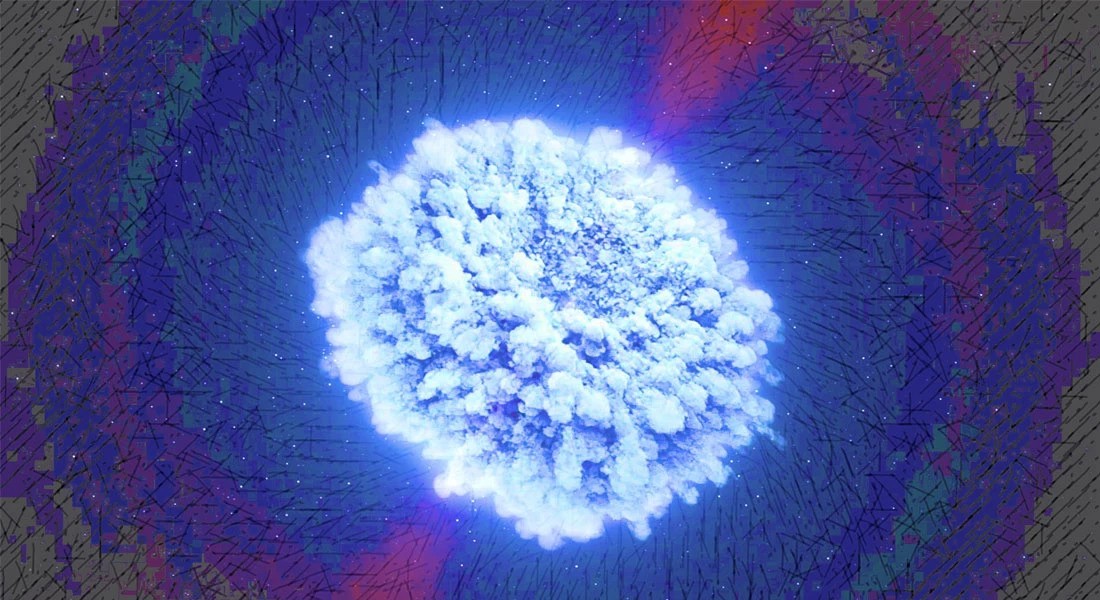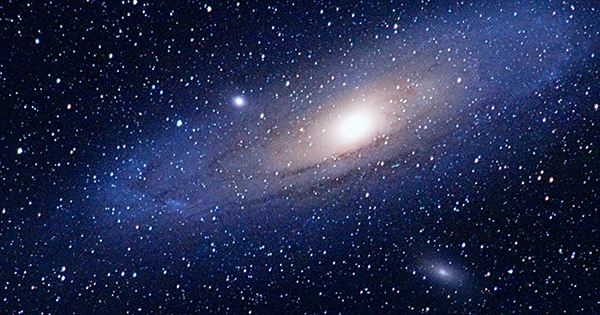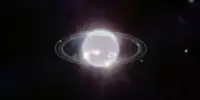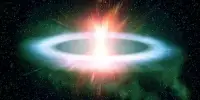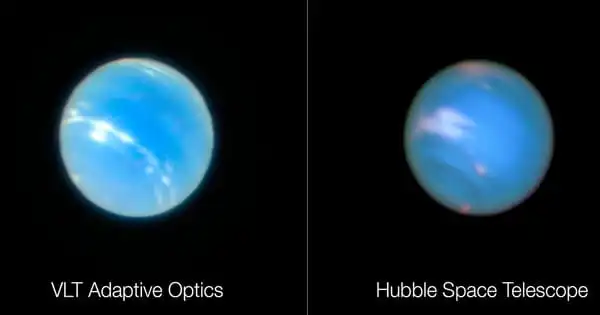The temperature of elementary particles has been observed in the radioactive glow following the collision of two neutron stars and the birth of a black hole. This has, for the first time, made it possible to measure the microscopic, physical properties in these cosmic events. Simultaneously, it reveals how snapshot observations made in an instant represents an object stretched out across time. The discovery was made by astrophysicists from the Niels Bohr Institute, University of Copenhagen and is published in the international scientific journal Astronomy & Astrophysics.
New method of observation shows the creation of heavy elements
The collision of two neutron stars has created the smallest black hole yet observed. The dramatic, cosmic collision resulted in, apart from the birth of a black hole, a ball of fire, expanding with nearly the speed of light. In the following days it shone with a luminosity comparable to hundreds of millions of Suns.
This luminous object, aka a kilonova, shines this bright because of the emission of large amounts of radiation from the decay of the heavy, radioactive elements created in the explosion.
By combining the measurements of the kilonova light, made with telescopes across the Globe, an international team of researchers, led by The Cosmic DAWN Center at the Niels Bohr Institute, have closed in on the enigmatic nature of the explosion and come closer to the answer of an old, astrophysical question: Where do the elements, heavier than iron, come from?
This astrophysical explosion develops dramatically hour by hour, so no single telescope can follow its entire story. The viewing angle of the individual telescopes to the event are blocked by the rotation of the Earth. But by combining the existing measurements from Australia, South Africa and The Hubble Space Telescope we can follow its development in great detail.
Albert Sneppen
Observatories all over the Globe took part in the observations
“This astrophysical explosion develops dramatically hour by hour, so no single telescope can follow its entire story. The viewing angle of the individual telescopes to the event are blocked by the rotation of the Earth. But by combining the existing measurements from Australia, South Africa and The Hubble Space Telescope we can follow its development in great detail. We show that the whole shows more than the sum of the individual sets of data” says Albert Sneppen, PhD student at the Niels Bohr Institute and leader of the new study.
The explosion resembles The Universe shortly after the Big Bang
Just after the collision the fragmented star-matter has a temperature of many billion degrees. A thousand times hotter than even the center of the Sun and comparable to the temperature of the Universe just one second after the Big Bang.
Temperatures this extreme results in electrons not being attached to atomic nuclei, but instead floating around in a so-called ionized plasma.
The electrons “dance” around. But in the ensuing moments, minutes, hours and days, the star-matter cools, just like the entire Universe after the Big Bang.
The fingerprint of Strontium is evidence of the creation of heavy elements
370,000 years after the Big Bang the Universe had cooled sufficiently for the electrons to attach to atomic nuclei and make the first atoms. Light could now travel freely in the Universe because it was no longer blocked by the free electrons.
This means that the earliest light we can see in the history of the Universe is this so-called “cosmic background radiation” — a patchwork of light, constituting the remote background of the night sky. A similar process of the unification of electrons with atomic nuclei can now be observed in the star-matter of the explosion.
One of the concrete results is the observation of heavy elements like Strontium and Yttrium. They are easy to detect, but it is likely that many other heavy elements which we were unsure of the origin of, were also created in the explosion.
“We can now see the moment where atomic nuclei and electrons are uniting in the afterglow. For the first time we see the creation of atoms, we can measure the temperature of the matter and see the micro physics in this remote explosion. It is like admiring three cosmic background radiation surrounding us from all sides, but here, we get to see everything from the outside. We see before, during and after the moment of birth of the atoms,” says Rasmus Damgaard, PhD student at Cosmic DAWN Center and co-author of the study.
Kasper Heintz, co-author and assistant professor at the Niels Bohr Institute continues: “The matter expands so fast and gains in size so rapidly, to the extent where it takes hours for the light to travel across the explosion. This is why, just by observing the remote end of the fire ball, we can see further back in the history of the explosion.
